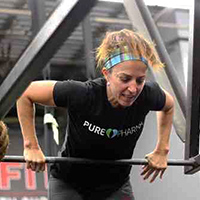

Having RA doesn’t mean you need to avoid strenuous exercise. See how one woman gained strength and improved her RA symptoms through CrossFit.

Challenging activities like CrossFit don't have to be off-limits because of RA.
Trying out a new fitness routine? Remember to start slowly, consider modifications, and know your own limits.
A physical therapist can teach you ways to avoid injury and maximize your workout.
The morning Keri Lanzarotta woke up with her first serious rheumatoid arthritis flare, she found it agonizing just to move: Even the upstairs bathroom felt painfully far away. But today, not even a flight of stairs — or more physically challenging moves — seem daunting. Thanks in part to CrossFit, Lanzarotta now doesn’t hesitate to take on stairs, lift a heavy barbell, or even crank out an impressive set of pull-ups.
Exercise is vital when you have RA, because arthritis can lead to significant muscle deficits and is associated with bone loss, says Joshua Baker, MD, an assistant professor of medicine at the University of Pennsylvania's Perelman School of Medicine and a physician at the Philadelphia VA Medical Center.
RA also increases your risk for cardiovascular disease. Exercise, on the other hand, not only improves cardiovascular fitness and builds muscle, but also improves your quality of life, according to a 2013 study in the International Journal of Clinical Rheumatology. But that's not all: a 2012 study review in Autoimmunity Reviews found that exercise has a positive effect on the immune response, which may help offset RA symptoms.
For Lanzarotta, that meant CrossFit: a high-intensity interval training (HIIT) regimen that aims to improve strength and conditioning. The workouts, which are always changing, combine weightlifting, body weight exercises, and aerobic training like jumping rope and running.
But the first step to being an athlete with RA is to get your arthritis under control before beginning an intense exercise regimen, Dr. Baker advises. The second step is to know your limitations and work within them. Lanzarotta follows this advice, which could be why she's been able to master the strenuous exercises of CrossFit.
For Lanzarotta, now 40, a teacher in Massapequa, New York, and the mother of three girls, the journey from diagnosis to finding a treatment that provided good joint relief — a biologic medication — took 10 years. During that time, she went from being an active college student to being fairly inactive. Her muscles became so weak that she couldn’t lift a half-gallon of juice from the fridge.
She gradually got back into shape by jogging on a treadmill and hiring a personal trainer, but she became bored. Four years ago, when her husband started CrossFit and encouraged her to try it, she took the leap. She started slowly and, on some days, would modify the exercises or use lighter weights than on others. But she's been able to do them all, and even excel at many.
RELATED: Pushing Through Pain: Life as a Triathlete With RA
She now does CrossFit four or five days a week, and rests on the other days. Her workout changes every day, but examples would be rounds of 30 double unders (jumping rope by spinning the rope twice around for every jump) and 15 snatches (lifting a barbell from the ground to overhead) for 10 minutes.
Lanzarotta also overhauled her diet, eliminating a lot of grains. “When I go back to have a slice of pizza or pasta, I feel the difference in my joints,” she says. A typical breakfast consists of scrambled eggs, half an avocado, tomatoes, and a serving of ham. Lunch might be a salad with chicken or turkey.
Exercise has a positive effect on the immune response, which may help offset RA symptoms.Tweet
Today, after four years of CrossFit, Lanzarotta is in shape, strong, and confident — and she can do more pull-ups than most people in her class. Perhaps the biggest plus is that most of her RA flares have subsided: though she still has about one a year, her flares tend to be minor since she started CrossFit. She doesn’t stop exercising during the time of a flare, but she does cut back on the amount of weight she uses, and how hard she pushes herself.
For anyone with RA who's thinking about doing CrossFit, Lanzarotta's advice is to go for it: “You might be surprised by what you can do."
Baker recommends starting slowly, and modifying or skipping exercises that hurt or make you feel unstable. “Muscle fatigue is okay, but if you feel like you might hurt yourself, modify,” he says.
Lanzarotta, for instance, knows just how much weight she can lift safely, and does push-ups on her knuckles instead of her palms.
You might also consider going to a few sessions with a physical therapist to learn strategies for avoiding injury and maximizing your workout, suggests Eric Robertson, doctor of physical therapy, who also serves as a clinical assistant professor at the University of Texas at El Paso.
For example, you may have to adjust your grip on dumbbells and bars, but you should gradually be able to build up the number of repetitions you do, he says.
Above all, enjoy yourself. There’s no evidence that intense exercise, when you’re doing it safely, will cause joint damage, Baker says.
Copyright © www.orthopaedics.win Bone Health All Rights Reserved